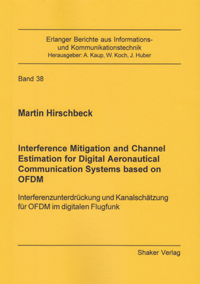
Shop : Details
Shop
Details

January 2017
Martin Hirschbeck
Interference Mitigation and Channel Estimation for Digital Aeronautical Communication Systems based on OFDM
Interferenzunterdrückung und Kanalschätzung für OFDM im digitalen Flugfunk
The L-band Digital Aeronautical Communication System 1 (LDACS1) is a proposal for the upcoming data link for air traffic control. Due to the scarcity of free spectra, it is planned to operate in the frequency neighborhood of Distance Measuring Equipment (DME), whose signals have an impulsive Gaussian-shaped nature and interfere with the reception of LDACS1 signals.
The first contribution is a low complexity iterative channel estimation (LCICE) technique which employs equalized data as support pilots in order to refine the pilot-aided channel estimation (PACE) in scenarios where pilot values suffer from interference.
The second and major contribution are proposals for the mitigation of the DME interference which mainly is impulsive with respect to the symbol duration of the signal but also frequency-selective with respect to the signal bandwidth:
- The first proposal is a filter bank pulse blanking (FBPB) approach with subbandselective blanking decisions. It may be extended to a subband-selective interference detection with soft blanking, which softly blanks the subband signals according to the detected and estimated subband-selective instantaneous powers of interference and signal.
- Among FBPB, a block-based frequency-selective interference mitigation (BBFIM) is proposed, which makes use of an efficient low complexity block processing via fast Fourier transform (FFT) and an interference mitigation in frequency domain.
Both proposals outperform the state of the art, whereby FBPB offers a tremendous robustness against impulsive interference. They may be adapted to any interference situation and may be applied together with any modulation scheme including single-carrier modulation at receiver-side without changing the standard.
The first contribution is a low complexity iterative channel estimation (LCICE) technique which employs equalized data as support pilots in order to refine the pilot-aided channel estimation (PACE) in scenarios where pilot values suffer from interference.
The second and major contribution are proposals for the mitigation of the DME interference which mainly is impulsive with respect to the symbol duration of the signal but also frequency-selective with respect to the signal bandwidth:
- The first proposal is a filter bank pulse blanking (FBPB) approach with subbandselective blanking decisions. It may be extended to a subband-selective interference detection with soft blanking, which softly blanks the subband signals according to the detected and estimated subband-selective instantaneous powers of interference and signal.
- Among FBPB, a block-based frequency-selective interference mitigation (BBFIM) is proposed, which makes use of an efficient low complexity block processing via fast Fourier transform (FFT) and an interference mitigation in frequency domain.
Both proposals outperform the state of the art, whereby FBPB offers a tremendous robustness against impulsive interference. They may be adapted to any interference situation and may be applied together with any modulation scheme including single-carrier modulation at receiver-side without changing the standard.
Keywords: Digital Communications; OFDM; LDACS1; Interference Mitigation; Channel Estimation; Filter Bank Pulse Blanking; Block-Based Frequency-Selective Interference Mitigation
Erlanger Berichte aus Informations- und Kommunikationstechnik
Edited by Prof. Dr. J. Huber, Prof. A. Kaup and Prof. Dr. W. Koch, Erlangen-Nürnberg
Volume 38
Available online documents for this title
You need Adobe Reader, to view these files. Here you will find a little help and information for downloading the PDF files.
Please note that the online documents cannot be printed or edited.
Please also see further information at: Help and Information.
Please also see further information at: Help and Information.
| Document |  | Document | ||
| Type |  | |||
| Costs |  | 37,35 € | ||
| Action |  | Purchase in obligation and download the file | ||
| Document |  | Table of contents | ||
| Type |  | |||
| Costs |  | free | ||
| Action |  | Download the file | ||
User settings for registered online customers (online documents)
You can change your address details here and access documents you have already ordered.
User
Not logged in
Export of bibliographic data
Shaker Verlag GmbH
Am Langen Graben 15a
52353 Düren
Germany
Am Langen Graben 15a
52353 Düren
Germany
Mon. - Thurs. 8:00 a.m. to 4:00 p.m.
Fri. 8:00 a.m. to 3:00 p.m.
Fri. 8:00 a.m. to 3:00 p.m.
Contact us. We will be happy to help you.

